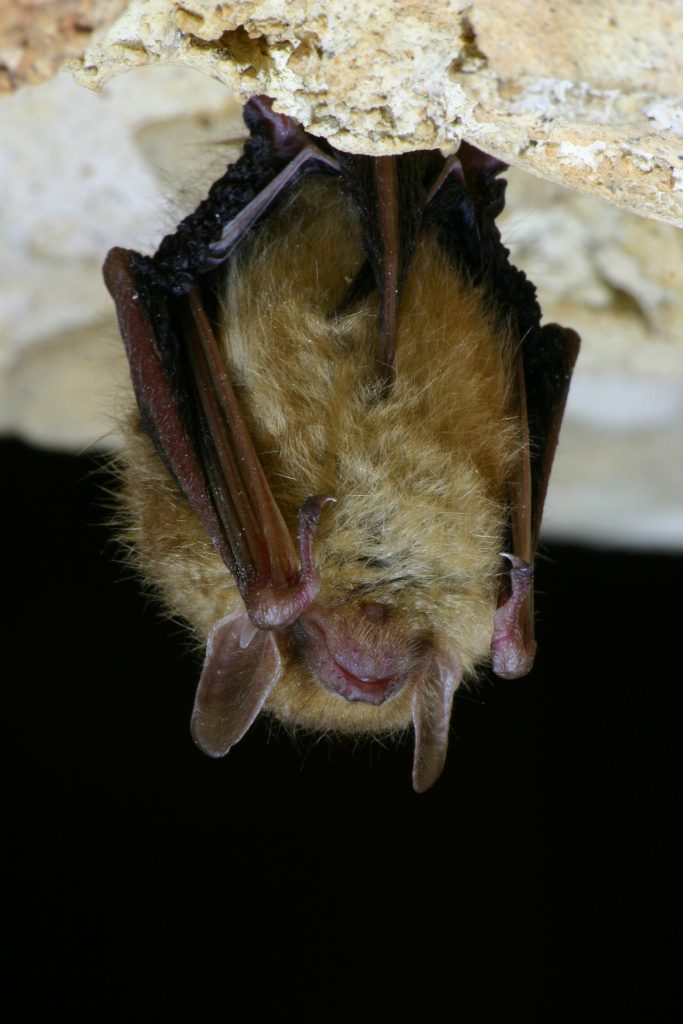Bats have a bad reputation, but they’re usually not a problem for humans. They fly around at night and help control bug populations. However, when they decide to roost in your home, they become a major nuisance.
If you’ve noticed bats in and around your property, it’s best to call a professional wildlife removal company because they can be destructive and carry diseases that may be dangerous.
Request Bat Removal Services ➔
Learn more about the various bat species and how to know if they’re in your attic.

What Does a Bat Look Like?
The U.S. is home to 47 different bat species. These flying mammals are distinguished by their large wings and small, furry bodies. They intimidate predators with their vicious-looking snouts and short, sharp teeth and are known to attack when threatened. Bats generally look similar with variations in color, wingspan, snouts and torsos.
Some are more rarely seen, but these eight species are fairly common in Texas:
- Mexican Free-Tailed: These Texas state mammals have brown-gray fur and long tails.
- Eastern Red: These bats measure up to 4″-5″ large with reddish fur.
- Seminole: Seminoles are 4″-5″ large with deep mahogany-colored fur.
- Hoary: The largest local species, Hoary bats can grow up to 6″ with frosted yellowish fur.
- Northern Yellow: These bats grow up to 4″ and have yellow fur.
- Big Brown: True to their name, Big Brown bats have brown fur and grow to 4″-5″.
- Evening: Evening bats are smaller at 3″-4″ and have dark, reddish or brown fur.
- Eastern Pipistrelle: These bats are the smallest at only 3″-3.5″ and have reddish-light brown fur.
Bats use high-frequency sounds to navigate and make bird-like fluttering and chirping noises.
What Do Bats Eat and What Attracts Them to Your Home?
Each bat’s diet varies according to their species. Most bats are insectivores, meaning they eat insects, but their diet may include fruit and nectar. In fact, a single bat can eat hundreds of thousands of insects every night. Their diet plays a role in controlling mosquito and fly populations.
Depending on how rich these food sources are in and around your home, you could face a bat infestation as they seek food and shelter. Their activity will likely increase if you live near an open field, near wetlands or have street lights and lamp posts nearby because of the insect abundance.
Where Do Bats Live in Your Home?
Bats prefer mild and temperate environments like woodlands, fields, tropical forests and river valleys. They are usually found in caves, trees, logs and rock crevices in the wild. They can be found in residential and urban areas as well, though, and tend to roostroost behind siding, in barns and sheds outside, and in attics inside homes.and businesses..
They usually enter through small roof gaps or exposed chimneys.
What Sounds Do Bats Make in Your Home?
Bats are nocturnal animals, which means they are active at night and roost during the day. They use echolocation to help navigate effectively. When listening for bat noises in the attic, you may hear high-pitched chirps or screeches.
You might also hear flapping noises at night. Their bodies make flapping and scratching noises at entry points to the attic and as they move around inside — another telltale sign of their presence.
Frequently Asked Questions
Take a look at some common questions about bats and our removal services.
Can You Remove Bats Permanently From My Home?
Yes, we can. We try various strategies to remove and exclude bats and don’t complete a job unless we’ve successfully prevented their re-entry.
Can Bats Damage My Attic?
Yes. Their excrement also called guano can build up in attics and make ceilings sag. Over time, you’ll be able to smell it. Inspect the outside of your home to look for bat excrement or grease stains from their fur.
During the inspection, look for possible entry points. Bats often leave guano around these areas.
Do Bats Pose a Health Risk?
Bats are common carriers for several diseases that can be dangerous to you and your family, including rabies and histoplasmosis. While transmission of these diseases isn’t especially common, they are still a concern if bats are in your home.
They should be removed immediately to prevent possible transmission.
Contact Urban Jungle for Bat Removal Services
If you have bats in your house, contact us today. Urban Jungle employs wildlife experts for animal trapping and removal in Texas. We’ll remove bats and perform exclusion and repair services to keep them out of your attic.
